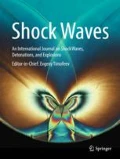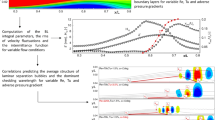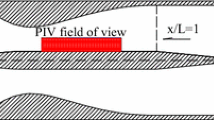Abstract
Although several mechanisms have been suggested as explanations for the low-frequency unsteadiness in shock wave/turbulent boundary layer interactions, questions remain on causes and effects. In this effort, we examine the observed asymmetry in large-scale shock motions to highlight which of the suggested mechanisms is most consistent with shock-speed observations and accompanying separation dynamics. The analysis is based on a flowfield obtained from a validated large eddy simulation of a fully separated interaction. A statistical analysis is used to determine the speed of bubble collapse relative to dilation. The low-pass filtering required to separate upstream from downstream motions in the presence of higher-frequency jitter is accomplished with a relatively new technique, empirical mode decomposition, that is very appropriate for this purpose. The dynamics of bubble dilation versus collapse are then elaborated with conditional dynamic mode decomposition (DMD) analyses on the respective pressure fields. Bubble breathing is shown to have a different structure during dilation than during collapse—larger structures are observed during collapse when fluid is expelled from the bubble. The nature of the DMD mode associated with Kelvin–Helmholtz (K–H) shedding in the mixing layer also differs between dilation and collapse: When the bubble is dilating, the structures at the dominant K–H frequency are larger than when the bubble is collapsing. Additionally, a link is established between the convecting K–H structures and corrugation observed along the reflected shock. Some aspects of the nature of the asymmetry are linked to the ease of eddy formation (K–H structures), which plays an important role in the collapse of the bubble.













Similar content being viewed by others
References
Souverein, L., Dupont, P., Debiève, J.-F., Dussauge, J.-P., van Oudheusden, J.-P., Scarano, F.: Effect of interaction strength on unsteadiness in turbulent shock-wave-induced separations. AIAA J. 48, 1480–1493 (2010). https://doi.org/10.2514/1.J050093
Touber, E., Sandham, N.: Comparison of three large-eddy simulations of shock-induced turbulent separation bubbles. Shock Waves 19, 469–478 (2009). https://doi.org/10.1007/s00193-009-0222-x
Priebe, S., Martín, M.: Direct numerical simulation of a reflected-shock-wave/turbulent-boundary-layer interaction. AIAA J. 47(5), 1173–1185 (2009). https://doi.org/10.2514/1.38821
Touber, E., Sandham, N.: Large-eddy simulation of low-frequency unsteadiness in a turbulent shock-induced separation bubble. Theoret. Comput. Fluid Dyn. 23, 79–107 (2009). https://doi.org/10.1007/s00162-009-0103-z
Dolling, D., Or, C.: Unsteadiness of the shock wave structure in attached and separated compression ramp flows. Exp. Fluids 3, 24–32 (1985). https://doi.org/10.1007/BF00285267
Muck, K.C., Dussauge, J.P., Bogdonoff, S.M.: Structure of the wall pressure fluctuations in a shock-induced separated turbulent flow. 23rd Aerospace Sciences Meeting, AIAA Paper 1985-0179 (1985). https://doi.org/10.2514/6.1985-179
Beresh, S., Clemens, N., Dolling, D.: Relationship between upstream turbulent boundary-layer velocity fluctuations and separation shock unsteadiness. AIAA J. 40(12), 2412–2422 (2002). https://doi.org/10.2514/2.1609
Helm, C., Pino Martin, M., Dupont, P.: Characterization of the shear layer in a Mach 3 shock/turbulent boundary layer interaction. 52nd Aerospace Sciences Meeting, AIAA Paper 2014-0941 (2014). https://doi.org/10.2514/6.2014-0941
Clemens, N.T., Narayanaswamy, V.: Low-frequency unsteadiness of shock wave/turbulent boundary layer interactions. Annu. Rev. Fluid Mech. 46, 469–92 (2014). https://doi.org/10.1146/annurev-fluid-010313-141346
Priebe, S., Pino Martín, M.: Low-frequency unsteadiness in shock wave-turbulent boundary layer interaction. J. Fluid Mech. 699, 1–49 (2012). https://doi.org/10.1017/jfm.2011.560
Piponniau, S., Dussauge, J., Debièvre, J., Dupont, P.: A simple model for low-frequency unsteadiness in shock-induced separation. J. Fluid Mech. 629, 87–108 (2009). https://doi.org/10.1017/S0022112009006417
Dussauge, J.-P., Dupont, P., Debièvre, J.-F.: Unsteadiness in shock wave boundary layer interactions with separation. Aerosp. Sci. Technol. 10, 85–91 (2006). https://doi.org/10.1016/j.ast.2005.09.006
Gaitonde, D.: Progress in shock wave/boundary layer interactions. Prog. Aerosp. Sci. 72, 80–99 (2015). https://doi.org/10.1016/j.paerosci.2014.09.002
Dupont, P., Haddad, C., Debièvre, J.F.: Space and time organization in a shock-induced boundary layer. J. Fluid Mech. 559, 255–277 (2006). https://doi.org/10.1017/S0022112006000267
Clemens, N.T., Narayanaswamy, V.: Shock/turbulent boundary layer interactions: Review of recent work on sources of unsteadiness. 39th AIAA Fluid Dynamics Conference, AIAA Paper 2009-3710 (2009). https://doi.org/10.2514/6.2009-3710
Ganapathisubramani, B., Clemens, N., Dolling, D.: Effects of upstream coherent structures on low-frequency motion of shock-induced turbulent separation. 45th AIAA Aerospace Sciences Meeting and Exhibit, AIAA Paper 2007-1141 (2007). https://doi.org/10.2514/6.2007-1141
Agostini, L., Larcheveque, L., Dupont, P., Debièvre, J.-F., Dussauge, J.-P.: Zones of influence and shock motion in a shock/boundary-layer interaction. AIAA J. 50(6), 1377–1387 (2012). https://doi.org/10.2514/1.J051516
Plotkin, K.: Shock wave oscillation driven by turbulent boundary-layer fluctuations. AIAA J. 13(8), 1036–1040 (1975). https://doi.org/10.2514/3.60501
Wu, M., Pino Martín, M.: Analysis of shock motion in shockwave and turbulent boundary layer interaction using direct numerical simulation data. J. Fluid Mech. 594, 71–83 (2008). https://doi.org/10.1017/S0022112007009044
Li, J., Priebe, S., Grube, N., Martín, P.M.: Conditional analysis of the unsteadiness in shock wave and turbulent boundary layer interactions. 52nd Aerospace Sciences Meeting, AIAA Paper 2014-0436 (2014). https://doi.org/10.2514/6.2014-0436
Souverein, L.: On the scaling and unsteadiness of shock induced separation. PhD Thesis, Universite de Provence Aix-Marseille, France (2010)
Huang, N.E., Shen, Z., Long, S.R., Wu, M.C., Shih, H.H., Zheng, Q., Yen, N.-C., Tung, C.C., Liu, H.H.: The empirical mode decomposition and the Hilbert spectrum for nonlinear and non-stationary time series analysis. Proc. R. Soc. Lond. Ser. A Math. Phys. Eng. Sci. 454(1971), 903–995 (1998). https://doi.org/10.1098/rspa.1998.0193
Huang, N.E., Shen, Z., Long, S.R.: A new view of nonlinear water waves: The Hilbert spectrum 1. Annu. Rev. Fluid Mech. 31, 417–457 (1999). https://doi.org/10.1146/annurev.fluid.31.1.417
Schmid, P.: Dynamic mode decomposition of numerical and experimental data. J. Fluid Mech. 656, 5–28 (2010). https://doi.org/10.1017/S0022112010001217
Aubard, G., Robinet, J., Gloerfelt, X.: Physical insight into the unsteady shock-wave turbulent boundary layer interaction using large eddy simulation. 7th International Symposium on Turbulence and Shear Flow Phenomena (TSFP-7) (2011)
Grilli, M., Schmid, P., Hickel, S., Adams, N.: Analysis of unsteady behaviour in shockwave turbulent boundary layer interaction. J. Fluid Mech. 700, 16–28 (2012). https://doi.org/10.1017/jfm.2012.37
Pirozzoli, S., Larsson, J., Nichols, J.W., Bernardini, M., Morgan, B.E., Lele, S.: Analysis of unsteady effects in shock/boundary layer interactions. Proceedings of the Summer Program, Center for Turbulence Research (2010)
Agostini, L., Larchevêque, L., Dupont, P.: Mechanism of shock unsteadiness in separated shock/boundary-layer interactions. Phys. Fluids 27, 126103 (2015). https://doi.org/10.1063/1.4937350
Dupont, P., Piponniau, S., Sidorenko, A., Debiève, J.: Investigation by particle image velocimetry measurements of oblique shock reflection with separation. AIAA J. 46, 1365–1370 (2008). https://doi.org/10.2514/1.30154
Garnier, E.: Stimulated detached eddy simulation of three-dimensional shock/boundary layer interaction. Shock Waves 19, 479–486 (2009). https://doi.org/10.1007/s00193-009-0233-7
Roe, P.: Approximate Riemann solvers, parameter vectors, and difference schemes. J. Comput. Phys. 43, 357–372 (1981). https://doi.org/10.1016/0021-9991(81)90128-5
Ducros, F., Ferrand, V., Nicoud, F., Weber, C., Darracq, D., Gacherieu, C., Poinsot, T.: Large-eddy simulation of the shock/turbulence interaction. J. Comput. Phys. 152, 517–549 (1999). https://doi.org/10.1006/jcph.1999.6238
Lenormand, E., Sagaut, P., Phuoc, L.T., Comte, P.: Subgrid-scale models for large-eddy simulations of compressible wall bounded flows. AIAA J. 38, 1340–1350 (2000). https://doi.org/10.2514/2.1133
Gear, C.W.: Numerical Initial Value Problems in Ordinary Differential Equations. Prentice Hall, Upper Saddle River (1971)
Jarrin, N., Benhamadouche, S., Laurence, D., Prosser, R.: A synthetic-eddy-method for generating inflow conditions for large-eddy simulations. Int. J. Heat Fluid Flow 27, 585–593 (2006). https://doi.org/10.1016/j.ijheatfluidflow.2006.02.006
Pamiès, M., Weiss, P.E., Garnier, E., Deck, S., Sagaut, P.: Generation of synthetic inflow data for large-eddy simulatin of spatially evolving wall-bounded flows. Phys. Fluids 21, 045103 (2009). https://doi.org/10.1063/1.3103881
Garnier, E., Sagaut, P., Deville, M.: Large-eddy simulation of the shock/boundary-layer interaction. AIAA J. 40, 1935–1944 (2002). https://doi.org/10.2514/2.1552
Adler, M.C., Gaitonde, D.V.: Dynamic linear response of a shock/turbulent-boundary-layer interaction using constrained perturbations. J. Fluid Mech. 840, 291–341 (2018). https://doi.org/10.1017/jfm.2018.70
Aubard, G., Gloerfelt, X., Robinet, J.-C.: Large-eddy simulation of broadband unsteadiness in a shock/boundary-layer interaction. AIAA J. 51(10), 2395–2409 (2013). https://doi.org/10.2514/1.J052249
Erengil, M., Dolling, D.: Correlation of separation shock motion with pressure fluctuations in the incoming boundary layer. AIAA J. 29, 1868–1877 (1991). https://doi.org/10.2514/3.10812
Dupont, P., Haddad, C., Ardissone, J.P., Debiève, J.F.: Space and time organization of a shock wave/turbulent boundary layer interaction. Aerosp. Sci. Technol. 9, 561–572 (2005). https://doi.org/10.1016/j.ast.2004.12.009
Flandrin, P., Rilling, G., Gonçalvés, P.: Empirical mode decomposition as a filter bank. IEEE Signal Process. Lett. 11(2), 112–114 (2004). https://doi.org/10.1109/LSP.2003.821662
Gonsalez, J., Dolling, D.: Correlation of interaction sweepback effects on the dynamics of shock-induced turbulent separation. 31st Aerospace Sciences Meeting, AIAA Paper 1993-0776 (1993). https://doi.org/10.2514/6.1993-776
Schmid, P., Sesterhenn, J.: Dynamic mode decomposition of numerical and experimental data. Sixty-First Annual Meeting of the APS Division of Fluid Dynamics (2008)
Rowley, C., Mezić, I., Bagheri, S., Schlatter, P., Henningson, D.: Spectral analysis of nonlinear flows. J. Fluid Mech. 641, 115–127 (2009). https://doi.org/10.1017/S0022112009992059
Mohan, A., Gaitonde, D., Visbal, M.R.: Model reduction and analysis of deep dynamic stall on a plunging airfoil using dynamic mode decomposition. Comput. Fluids 129, 1–19 (2016). https://doi.org/10.1016/j.compfluid.2016.01.017
Tu, H.J.: Dynamic mode decomposition: theory and applications. PhD Thesis, Princeton University (2013)
Martin, M., Priebe, S., Helm, C.: Upstream and downstream influence on STBLI instability. 46th AIAA Fluid Dynamics Conference, AIAA Paper 2016-3341 (2016). https://doi.org/10.2514/6.2016-3341
Acknowledgements
The authors appreciate the sponsorship of the Air Force Office of Scientific Research (Monitor: I. Leyva) and the Collaborative Center for Aeronautical Sciences. We also gratefully acknowledge the supersonic group from IUSTI for sharing their database obtained using resources from Institut du Developpement et des Ressources en Informatique Scientifique (IDRIS) under the allocation 2009-021877 made by Grand Equipement National de Calcul Intensif. The post-processing analysis was performed with grants of computer time from the DoD HPCMP and the Ohio Supercomputer Center. Some figures have been made with complimentary licenses of FieldView obtained from Intelligent Light under the University Partners Program.
Funding
Funding was provided by Air Force Office of Scientific Research (Grant No. FA95550-14-1-0167) and Air Force Research Laboratory (Grant No. FA8650-13-2-2442).
Author information
Authors and Affiliations
Corresponding author
Additional information
Communicated by H. Olivier and A. Higgins.
Publisher's Note
Springer Nature remains neutral with regard to jurisdictional claims in published maps and institutional affiliations.
Rights and permissions
About this article
Cite this article
Waindim, M., Agostini, L., Larchêveque, L. et al. Dynamics of separation bubble dilation and collapse in shock wave/turbulent boundary layer interactions. Shock Waves 30, 63–75 (2020). https://doi.org/10.1007/s00193-019-00918-y
Received:
Revised:
Accepted:
Published:
Issue Date:
DOI: https://doi.org/10.1007/s00193-019-00918-y




